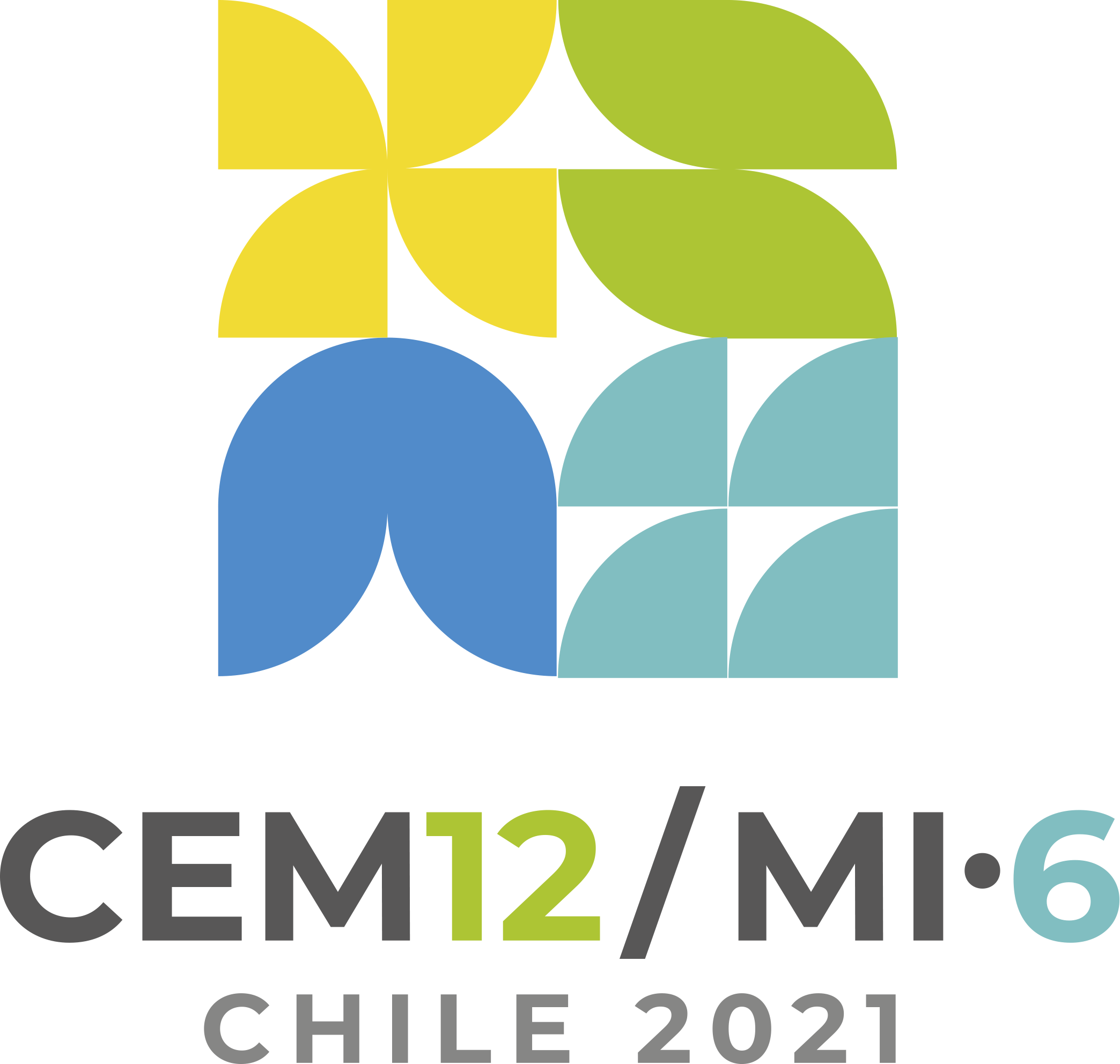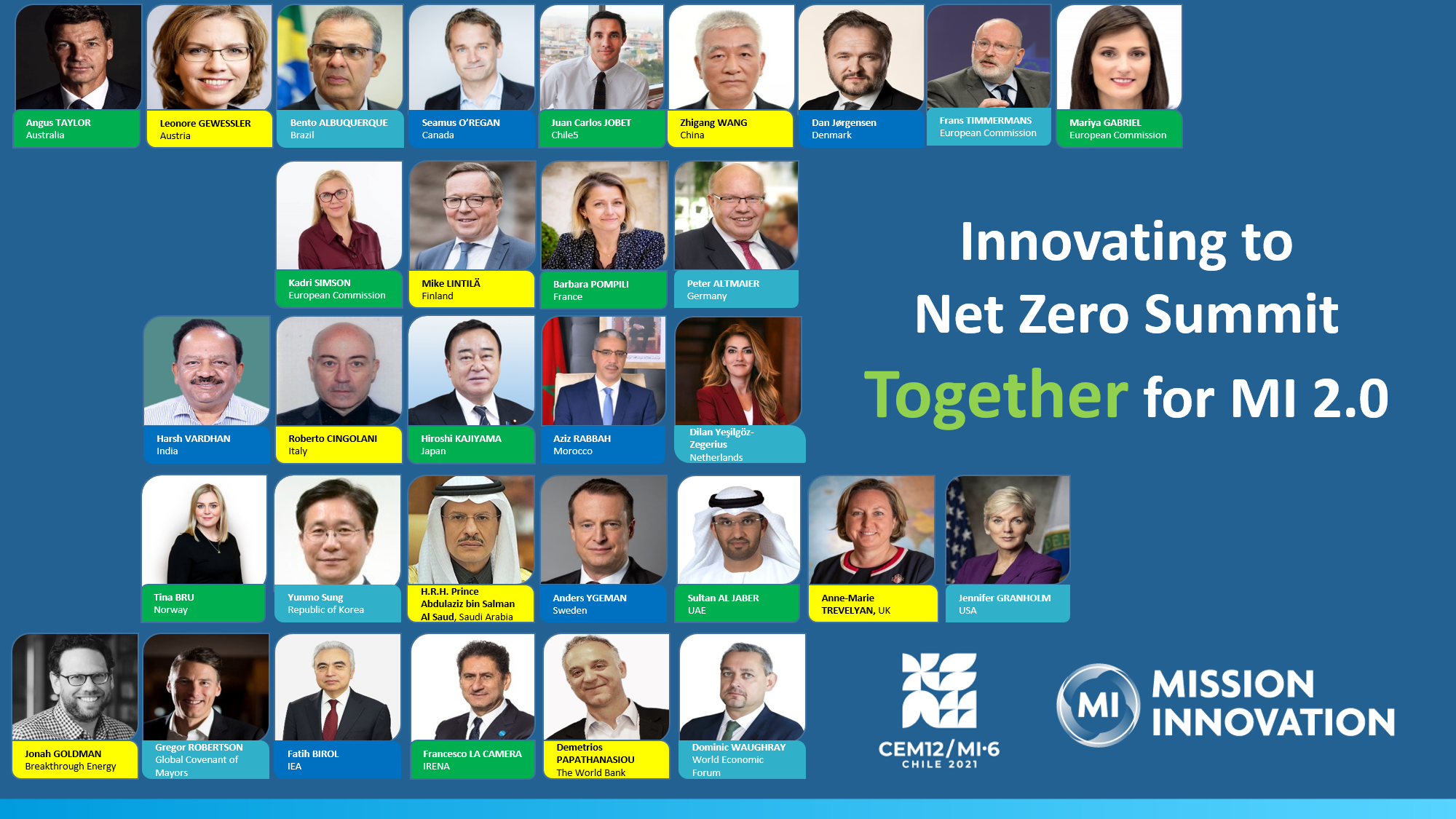Monday 31 May 2021 – Sunday 6 June, 2021
Hosted by the Government of Chile
***Missed it? Watch the recordings here!***
Mission Innovation 2.0 and a decade of clean energy innovation to accelerate achieving the Paris Agreement goals launched at the Innovating to Net Zero Summit, hosted by Chile on 2 June, 2021.
Santiago, Chile, June 2, 2021 – 23 governments[1] have collectively launched bold new plans to catalyze action and spearhead a decade of innovation to drive global investment in clean energy research, development and demonstrations. The goal is to make clean energy affordable, attractive and accessible for all this decade, to accelerate action towards the Paris Agreement and net zero pathways. Mission Innovation 2.0 is the second phase of the global Mission Innovation initiative, launched alongside the Paris Agreement at the 2015 COP21 conference. Its members – collectively responsible for over 90% of global public investment in clean energy innovation – are committed to increase investment and collaboration to deliver the technologies needed to overcome the world’s most difficult climate challenges. Achieving the Paris Agreement goals of limiting global warming to well below 2 degrees Celsius, compared to pre-industrial levels, requires huge leaps in energy innovation this decade. Half of the global emissions reductions required to achieve national and global climate targets by 2050 depend on technologies that exist today, but are only at demonstration or prototype phase[i]. These technologies are not yet sufficiently effective or affordable to be deployed at scale, such as clean hydrogen, advanced battery storage or zero emission fuels. Mission Innovation 2.0 will catalyze public-private action and investment through sector-specific Missions that accelerate the development of clean energy solutions in critical areas, to reach tipping points this decade in their affordability. The goal is to make them attractive and accessible to all countries and give governments worldwide the confidence to set ambitious clean energy pathways. In a Joint Statement launching Mission Innovation 2.0, Energy, Research and Science Ministers representing 22 countries and the European Commission (on behalf of the European Union) stated: “As many governments and businesses around the world continue to commit to ambitious climate goals and to reach net zero emissions, the need for innovation has never been greater or more urgent. To achieve the Paris Agreement, all sectors of the economy need access to cost competitive clean energy solutions this decade.” In the statement, ministers committed to step up their collective ambition and cooperation; mobilize and connect global research, development and demonstration efforts to maximize the impact of these investments; build confidence in clean energy solutions; and develop pathways to deployment. They also committed to develop National Innovation Pathways that describe how they will enhance ambition to pioneer clean energy technologies and/or sectors to meet their climate and energy goals up to 2030. Mission Innovation 2.0 was officially launched at the Innovating to Net Zero Summit, hosted by Chile. Speaking at the launch, Sebastián Piñera, President of Chile, said: “Chile is proud to kick off this exciting next chapter of Mission Innovation in this vital year of climate action. Through innovation, collaboration and most importantly, action, we have the tools we need to fight climate change and meet the goals of the Paris Agreement. As we focus on this new decade of innovation, Mission Innovation members’ shared goal of accelerating the transition to faster, cleaner, affordable energy for all is more achievable than ever.” John Kerry, U.S. Special Presidential Envoy for Climate, said: “The launch of Mission Innovation 2.0 is an important step forward to reach our collective climate goals. Reaching net-zero emissions by 2050 will require urgent action by 2030, both to deploy the clean energy technologies we already have as well as to develop, demonstrate, and scale the innovations we’ll need to fully decarbonize the global economy. The United States is reinvigorating its leadership in this exciting new phase, in which the Mission Innovation community will advance the technologies we need for slashing emissions across challenging applications including zero-carbon hydrogen, clean long-distance transportation, and carbon dioxide removal.” The launch of Mission Innovation 2.0 is a key milestone in the build-up to the COP26 climate conference in Glasgow, UK, in November. Alok Sharma, COP26 President for the UK, said: “Accelerating the transition to clean energy will be essential if we are to keep the 1.5 degree goal within reach. To achieve this, international collaboration on innovation in sectors like power, transport and industry will be crucial. We need countries to commit to raising their climate ambition, to take action and to make this target a reality.” Mission Innovation is also collaborating with a network of partner organisations worldwide to accelerate innovation. António Guterres, Secretary-General of the United Nations, said: “Mission Innovation is playing a crucial role in accelerating solutions to address climate disruption. We must cut global emissions by 45 per cent by 2030 from 2010 levels and achieve net zero emissions by 2050 and to do that, we must act fast. Every sector and every industry must have an action plan with robust intermediate goals. With less than six months to COP26, I welcome the commitments from governments and the private sector today that will help us achieve our shared objectives.” Fatih Birol, Executive Director, International Energy Agency, said: “The IEA’s Global Roadmap to Net Zero by 2050 shows that by mid-century, almost half the reductions in CO2 emissions will need to come from technologies that are currently at the demonstration or prototype phase. This means major innovation efforts are required by 2030 in order to bring these new technologies to market in time and scale them up over the coming decades. Our Roadmap also highlights that without stronger international cooperation on clean energy innovation, it could decades longer for the world to reach net-zero emissions. Mission Innovation is a clear example of how governments can work together in this critical area – and the IEA is committed to supporting these efforts to boost clean energy innovation to meet our shared climate goals.” Jonah Goldman, Managing Director of Breakthrough Energy, said: “To succeed in preventing the climate crisis, the world needs to accelerate clean energy innovation and eliminate green premiums so every community around the world can afford to deploy green technologies at scale. This will only happen if we build a new generation of public-private partnerships that are squarely focused on climate impact and emission reductions. Since 2015, Mission Innovation has been an indispensable partner in driving the global clean energy agenda. Today, it is entering an exciting new phase in which an even greater focus on deployment, scale and market creation offer the promise of a decade of clean energy innovation. Breakthrough Energy is delighted to be part of this important process.” Since 2015, Mission Innovation member governments have increased clean energy innovation investments by a cumulative total of USD$18bn. Investment is now USD$5.8bn per year higher than in 2015. Canada, Chile, Finland, Japan, the Netherlands, Norway, the Republic of Korea and the UK have doubled their levels of investment and Denmark, Germany, Sweden and the European Commission have increased investment by 75% or more against their 2015 baselines. National investments have already supported the research, development or demonstration of nearly 1,500 innovations with the potential to avoid more than 21 gigatons of CO2 per year by 2030, if fully deployed[ii]. In addition, through Mission Innovation, an additional USD$1.6bn funding has supported 157 new international collaborations since 2015, supporting clean energy innovation globally[iii]. A series of new Missions will accelerate the frontiers of innovation and drive down the cost of technologies by driving public-private action in areas critical to global clean energy transitions, starting with power systems, clean hydrogen and shipping. They will catalyze global action towards ambitious innovation goals and encourage demand pull for these technologies. Each Mission is led by a coalition of countries and brings together governments and the private sector to focus innovation efforts. The Missions are underpinned by a new global Innovation Platform to strengthen confidence and awareness in emerging innovations and maximize the impact of national investments. Green Powered Future – led by China, Italy and the UK – aims to demonstrate that, by 2030, power systems in different geographies and climates will be able to effectively integrate up to 100% variable renewable energy, such as wind and solar, in their generation mix and maintain a cost-efficient, secure and resilient system. Clean Hydrogen – led by Australia, Chile, the UK, the US and European Union – aims to make clean hydrogen[iv] cost competitive to the end user by reducing end-to-end costs to USD $2 per kilogram by 2030. The Mission will increase research and development in hydrogen technologies and deliver at least 100 hydrogen valleys across production, storage and end use of hydrogen worldwide. Zero-Emissions Shipping – led by Denmark, the US and Norway, together with the Global Maritime Forum and the Maersk McKinney Moller Center for Zero Carbon Shipping – aims for ships capable of running on zero-emission fuels (such as green hydrogen, ammonia and methanol) to make up at least 5% of the global deep-sea fleet by 2030. Innovation Platform – will build global confidence in emerging clean energy solutions by tracking innovation progress, enhancing knowledge-exchange and collaboration and working with investors, innovators and end-users to accelerate technologies to market. As part of the Platform, India has today launched the Mission Innovation CleanTech Exchange which will create a network of incubators across member countries. The network will provide access to the expertise and market insights needed to support new technologies to access new markets globally. Patrick Child, Deputy Director-General, Research and Innovation at the European Commission and Chair of the Mission Innovation Steering Committee, said: “Today, as many governments and businesses around the world commit to ambitious climate goals and reaching net zero emissions, the need for innovation has never been greater or more urgent. Cost-effective, clean energy solutions must become a reality for everyone. By transforming how we generate, use, and distribute energy, we can drive investment, create jobs, and secure a cleaner planet for future generations.” [1] Austria, Australia, Brazil, Canada, Chile, China, Denmark, Finland, France, Germany, India, Italy, Japan, the Republic of Korea, Morocco, the Netherlands, Norway, Saudi Arabia, Sweden, the United Arab Emirates, the United Kingdom, the United States of America, and the European Commission (on behalf of the European Union). [i] See IEA Net Zero by 2050 report [ii] See Net-Zero Compatible Innovations Initiative [iii] This has included USD$3 million for the Global Cooling Prize which identified two new technologies that can deliver cooling with 5x less climate impact; a total of USD$17 million allocated to support collaboration between Indian institutions and innovators in MI countries; the Canada-UK Power Forward Challenge which funded consortia with up to CAD$3M / £1.8M to develop pilot-scale demonstrations of innovative smart grid solution; Republic of Korea supported collaboration with 5 MI members through a USD$21.6 million joint research programme and the MICall series initiated by Austria and Sweden which has provided €47 million for two multilateral funding calls. [iv] Green hydrogen produced from energy renewable sources and blue hydrogen where carbon emissions are captured and stored.
Highlights from MI-6 and the Innovating to Net Zero Summit
23 governments responsible for over 90% of global public investment in clean energy innovation commit to greater action to make clean energy affordable, attractive and accessible to all this decade.
Mission Innovation 2.0 – spearheading a decade of innovation with new Missions for action

